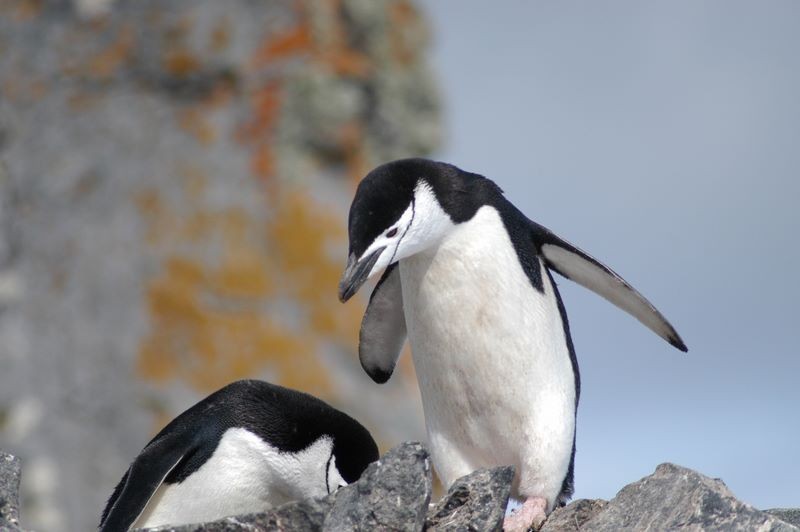Chinstrap Penguin
A species of Stiff-tailed Penguins Scientific name : Pygoscelis antarcticus Genus : Stiff-tailed Penguins
Chinstrap Penguin, A species of Stiff-tailed Penguins
Botanical name: Pygoscelis antarcticus
Genus: Stiff-tailed Penguins
Content
Description People often ask General Info
 Photo By Ivancillo18 , used under CC-BY-SA-3.0 /Cropped and compressed from original
Photo By Ivancillo18 , used under CC-BY-SA-3.0 /Cropped and compressed from original Description
The chinstrap penguin grows to a length of 68–76 cm (27–30 in) and a weight of 3.2–5.3 kg (7.1–11.7 lb), with the weight varying with the time of year. Males are greater in weight and height than females. The adult chinstrap's flippers are black with a white edge; the inner sides of the flippers are white. The face is white extending behind the eyes, which are reddish brown; the chin and throat are white, as well, while the short bill is black. The strong legs and the webbed feet are pink. Its short, stumpy legs give it a distinct waddle when it walks. The chinstrap penguin's black back and white underside provide camouflage in the form of countershading when viewed from above or below, helping to avoid detection by its predators. 
Size
77 cm
Life Expectancy
15-20 years
Nest Placement
Ground
Feeding Habits
Chinstrap Penguin predominantly feed on Antarctic krill, supplemented with other crustaceans and some fish. They forage by diving, utilizing their streamlined bodies to capture prey. Chinstrap Penguin have a specialized diet and are well-adapted to their cold, marine environment.
Habitat
Chinstrap Penguin is a marine bird predominantly found in areas characterized by light pack ice, with coverage ranging from 10 to 30 percent. This species prefers nesting on irregular, rocky coastlines in ice-free zones. It is an inshore feeder and is known to be intolerant of heavy ice conditions. Its breeding range, mainly in broader geographical polar regions, has been expanding southward in recent decades, which may coincide with shifts in ice distribution and availability due to climatic changes.
Dite type
Piscivorous
People often ask
General Info
Feeding Habits
Bird food type
Behavior
On land, they build circular nests from stones, and lay two eggs, which are incubated by both the male and the female for shifts around 6 days each. The chicks hatch after around 37 days, and have fluffy grey backs and white fronts. The chicks stay in the nest for 20–30 days before they go to join other chicks in a crèche. Around 50–60 days old, they moult, gaining their adult feathers and go to sea. Chinstrap penguins are generally considered to be the most aggressive and ill-tempered species of penguin. 
Distribution Area
Chinstrap penguins have a circumpolar distribution. They breed in Antarctica, Argentina, Bouvet Island, Chile, the Falkland Islands, the French Southern Territories, and South Georgia and the South Sandwich Islands. Vagrant individuals have been found in New Zealand, the islands of Saint Helena and Tristan da Cunha, and South Africa. 
Species Status
The global population of the chinstrap penguins is estimated to be at least eight million. Although it is believed to be decreasing overall, its population is not severely fragmented and in many sites it is increasing or stable. The chinstrap penguin is primarily threatened by climate change. In several parts of its range, climate change decreases the abundance of krill, which likely makes reproduction less successful. For instance, a 2019 expedition to breeding grounds on Elephant Island show a fifty percent population decline in just under fifty years. Other potential threats include volcanic events and the fishing of krill by humans. Several conservation actions are taking place for this species. Multiple areas where it lives are being monitored for long periods. Conservation actions proposed for the future include more monitoring and researching of its population, range, and behavior. It is listed as a species of least concern on the IUCN Red List as of 2016, due to its large range and population, following five previous assessments of the same status from 2004 to 2012 and three assessments as "unknown" from 1988 to 2000. 
Scientific Classification
Phylum
Chordates Class
Birds Order
Penguins Family
Penguins Genus
Stiff-tailed Penguins Species
Chinstrap Penguin